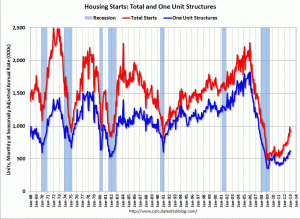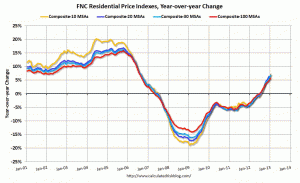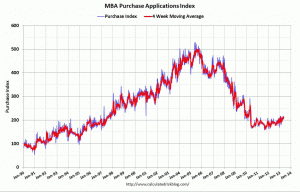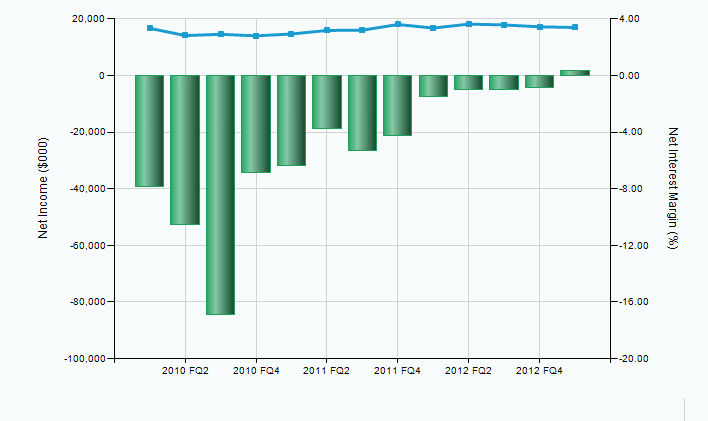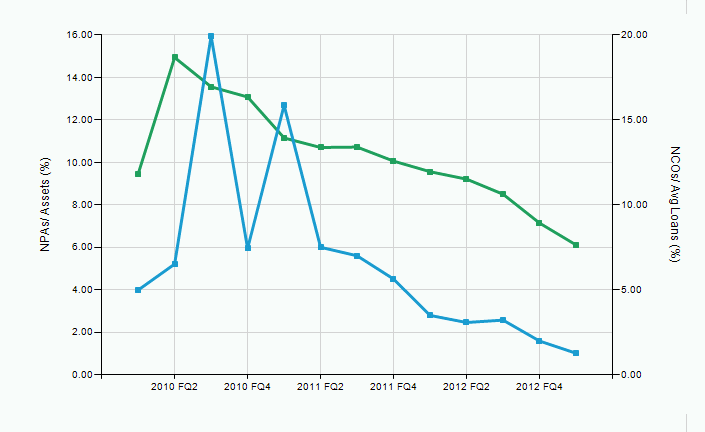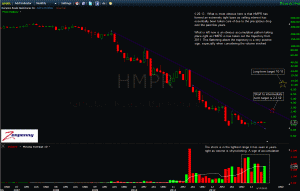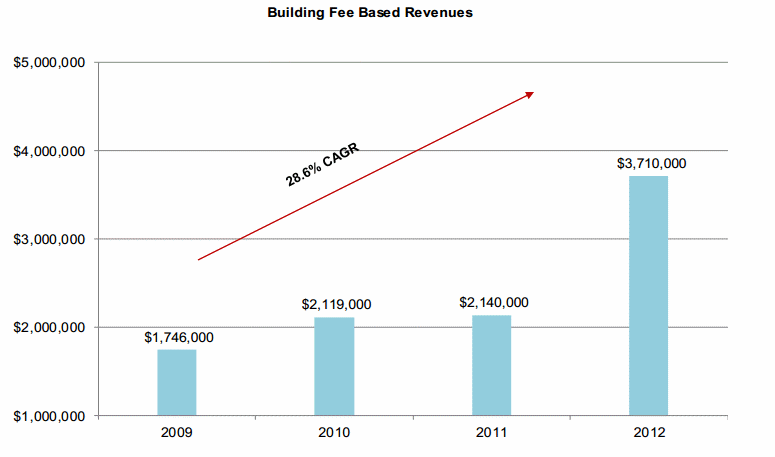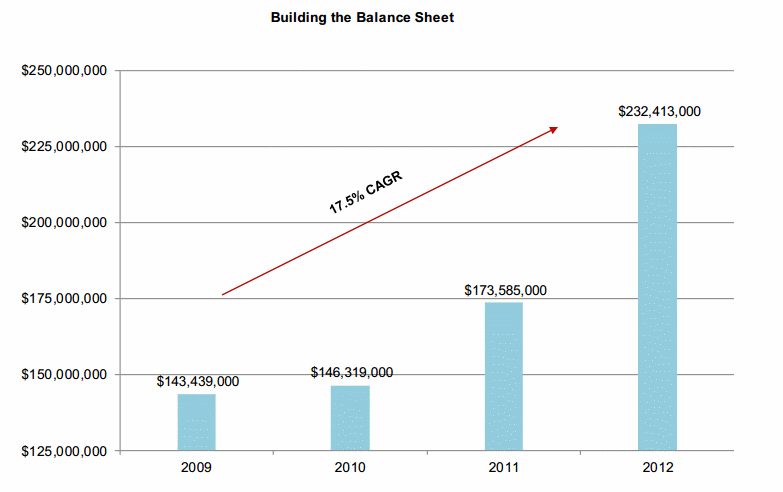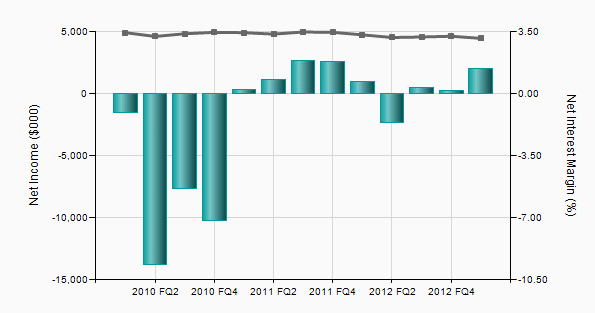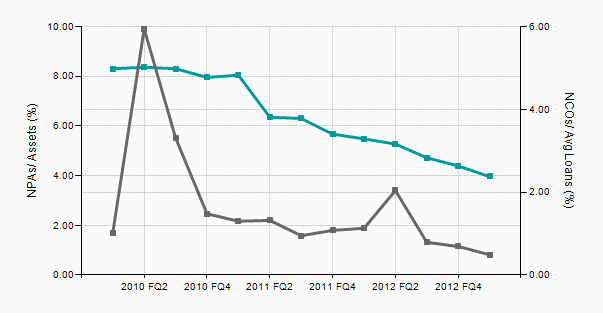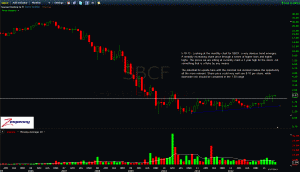MAKING THE CASE FOR INVESTING IN REGIONAL BANKS: STARRING HMPR & SBCF
AN OVERVIEW
We begin this exploration of the opportunities prevalent in today's investment environment by exploring trends in the real estate market, with a focus on how those trends are influencing the balance sheets of small, regional bank names. It goes without saying that small regional banks were the hardest hit among the names from the recent debt/housing crisis. In fact, there remain nearly 800 banks on the problem bank list published on the Calculated Risk Blog monthly. Both of the names presented in this report today are on the troubled bank list.
I have expressed my disdain of "green light" investing in my postings on many occasions. Green light investing is the act of waiting for the market to give you a thumbs up, shiatsu massage and steak dinner to make your decision to invest a comfortable, cozy and pleasant experience. The greatest opportunities in the marketplace are those born from the inability of market participants to surmise the risks involved correctly. To be cozy and comfortable in an investment is a sign that the marketplace for that particular idea has matured to the point of a positive consensus opinion. It is in that positive consensus opinion that the seeds of dramatic and sudden losses are born.
To invest in small, regional bank names here is certainly not the uncertain proposition it was in 2010 and 2011, when a majority of the names in the sector were seeking relief from government, hedge fund and private equity sources. There is, however, a large degree of uncertainty that remains due to the sustained losses of a period of years, the resulting dilution that occurred as a result of the numerous rescue packages thrown together to aide these companies and the inability to gauge accurately whether the recovery in real estate is sustainable over the long term.
As exhibited by the two charts below, we are in the early period of a recovery perhaps reaching normalized levels into 2015:
click chart to enlarge (all charts courtesy of Calculated Risk)
Perhaps more importantly with respect to regional banking investments, according to the Mortgage Bankers Association, the 4 week moving average of mortgage applications just made a 4 year high as demonstrated by the chart below:
With what is an obvious environment geared towards firming, with the potential of a ramping up taking place over the next few years, let's look at two regional bank names that stand to benefit.
Hampton Roads Bankshares (HMPR)
Hampton Roads Bankshares, Inc. operates as the bank holding company for Bank of Hampton Roads (BOHR) and Shore Bank that provides community and commercial banking services primarily to individuals and small to medium-sized businesses. As of December 31, 2012, the company operated 40 branches, as well as a network of 48 ATMs. It has operations in Virginia and North Carolina; and the eastern shore of Maryland and Virginia. The company was founded in 1961 and is headquartered in Virginia Beach, Virginia.
THE NEGATIVES FIRST
Let's get the negatives out of the way before turning to why there is a substantial opportunity in HMPR:
- The Company has received a grand jury subpoena from the United States Department of Justice, Criminal Division. Although the Company has been advised that it is not a target or a subject of the investigation at this time and we do not believe we will become a target or a subject of the investigation, there can be no assurances as to the timing or eventual outcome of the related investigation
- There is a formal investigation taking place by the SEC. The investigation by the SEC may result in penalties, sanctions, or a restatement of our previously issued financial statements
- The company has taken part in numerous capital raises, with the most recent being a rights offering that took place at a price well below where the market was trading at the time. The offering was announced in May of 2012, with the rights being offered at a price of .70 cents per share. The announcement of the offering took the price from the 3 range down to the low 1 range in a matter of weeks.
WHERE IS THE RISK?
I suppose the most pressing question at this point would be why to invest in such a heathen of misery?
The answer is a simple one: Risk has been mitigated to the point of being minimal. This is due to two factors:
1. The unreasonably low price the rights offering took place at to insure max participation or perhaps as a result of the demands of the private equity investors who basically control this company (more on that later) has artificially suppressed the shares for the better part of a year. At what was arguably the peak of misery and pessimism within the real estate crisis late 2010-early 2011 shares were trading in the 15-20 range. The shares attempted to base in the $3 range in 2012. Then management announced the rights offering, which further punished investors. The "give up" among investors in this name is obvious. That "give up" is where the opportunity lies. The outstanding float, as a result of the evacuation of the retail base and subsequent rescue of the company, is 91% in the hands of private equity investors, leaving only 9% of the float available for you and me. The .70 cent rights offering price is an iron curtain. In fact, downside should be significantly ahead of the rights offering price at 1-1.10, leaving investors with 20-30 percent downside.
2. The obvious turnaround taking place in the real estate market has actually propelled HMPR into profitability for the first time in years. In the most recent 10-Q the company states the following:
Throughout the first three months of 2013, economic conditions in the markets in which our borrowers operate continued their slow recovery and the levels of loan delinquencies and rates of default continued to improve. The Company reported net income for the three month period ended March 31, 2013 primarily resulting from strong mortgage earnings and significant decreases in both the provision for loan losses and losses on other real estate owned and repossessed assets, partially offset by an impairment of premises and equipment that is further described in the notes of this report. As of March 31, 2013, the Company exceeded the regulatory capital minimums and BOHR and Shore were considered "well capitalized" under the risk-based capital standards.
Currently, the U.S. economy appears to be slowly recovering from one of its longest and most severe economic recessions in recent history. Continued improvements in general economic conditions and credit performance of the Company's loan portfolio coupled with cost savings initiatives and strong performance from our mortgage subsidiary resulted in $632 thousand net income for the three months ended March 31, 2013. While the pace of economic growth remains slow and regulatory and legislative friction continues to hamper the recovery, we expect to be profitable for the full year 2013.
During 2012 and the first three months of 2013, problem loans were reduced significantly from previous levels. As a result of this improvement and continued declines in the loan portfolio due to pay-downs and charge-offs, there was no provision for loan losses during the quarter ended March 31, 2013 compared to $7.3 million in the same period in 2012. We expect that the provision for loan losses will continue to be favorably impacted by these trends. Additionally, during the first quarter of 2013, losses on other real estate owned and repossessed assets decreased $2.1 million compared to the first quarter of 2012.
Thus far, we have a picture being painted of:
1. A regional banking name that has been devastated at the hands of the debt crisis between 2008-2012
2. A firming real estate market that is showing sustainable signs of improvement
3. A regional banking name that is benefiting from these improvements in the lending environment by showing profitability for the first time in years
PROBLEM LOANS GOING BYE-BYE
One of the highlights of the recent 10-Q is the statement by HMPR management that "problem loans were reduced significantly from previous levels." Let's take a closer look at exactly how much of an improvement is taking place by looking at NPAs (Non-Performing Assets, essentially loans that are in threat of default) and NCOs (Net Charge Offs are debt that have no chance of recovery).
Another piece added to the picture: Improvements in loan losses and the threat of loan losses.
THE DILUTION FACTOR AND WHAT IT MEANS GOING FORWARD
Moving onto the chain of capital raises that have allowed HMPR to stick around to enjoy its first quarter in years of net income recently. As you read through the list below, keep in mind that these injections of capital started in 2010 with the stock trading significantly higher than where it is now:
On August 11, 2010, the Company entered into definitive investment agreements (the “Investment Agreements”) with a group of investors to purchase $255 million of newly-issued common shares from the Company through private placement transactions (the “2010 Private Placement”).
As part of the 2010 Private Placement, on September 30, 2010, the Company issued $235 million worth of common shares, or approximately 23,500,000 shares of Adjusted Common Stock, at a price of $10.00 per Adjusted Share, in the following amounts to the following entities.
| Investor | Number of Shares of Adjusted Common Stock Issued |
|||
| Carlyle Financial Services Harbor, L.P | 6,598,279 | |||
| ACMO-HR, L.L.C | 6,120,808 | |||
| CapGen Capital Group VI, LP | 4,568,951 | |||
| M.H. Davidson & Co. | 62,453 | |||
| Davidson Kempner Partners | 434,789 | |||
| Davidson Kempner Institutional Partners, L.P. | 879,551 | |||
| Davidson Kempner International, Ltd. | 1,013,479 | |||
| Davidson Kempner Distressed Opportunities International, Ltd. | 231,894 | |||
| Davidson Kempner Distressed Opportunities Funds LP | 108,819 | |||
| Fir Tree Value Master Fund, L.P. | 1,807,753 | |||
| Fir Tree REOF II Master Fund, LLC | 923,229 | |||
| C12 Protium Value Opportunities Ltd. | 750,000 | |||
Needless to say, the first act of dilution was an absolute debacle for everyone involved. The current shareholders got pummeled. The companies that took part in the private placement ended up with massive losses a little over one year later.
Fast forward to mid-2012, HMPR is in need of more capital from a group of highly-disappointed, angry private equity and hedge fund partners. I have an exclusive transcript of the call between HMPR Management and Carlyle, Fir Tree and CapGen. Here is an excerpt:
HMPR Management: Hey brother, its the HMPR CEO and things aren't going the way we expected. I think we need more cash.
Carlyle, Fir Tree, CapGen: Well dudes, look here. We took a bath on the last capital raise we took part in. None of us could get the AMG package on the Mercedes we wanted last Christmas because of you guys. Instead of having steak and lobster for lunch, we are all ordering steak and french fries. We are embarrassed by this whole thing. You are making us look bad. But, we don't our investment to go to zero so we will help you guys out.
HMPR Management: You guys are the best. You won't regret this. Dinner at Sizzler tonight? It's on me.
Carlyle, Fir Tree, CapGen: Sure dude, we are in. But here's the deal. We want to do a rights offering at .70 cents that will be backstopped by our firms. Since there are no retail investors that own your company anymore, we will end up buying a majority of the rights offering.
HMPR Management: Brother...our stock is trading at $3. Stop pulling my leg.
Carlyle, Fir Tree, CapGen: (Silence)
HMPR Management: Bro?
Carlyle, Fir Tree, CapGen: (Silence)
HMPR Management: Done. Rights offering at .70 cents per share.
On May 21, 2012 the Company entered into a standby purchase agreement (the “Standby Purchase Agreement”) with the Investors that provided for, among other things, the sale of an aggregate of $50 million of the Company’s common stock at a price of $0.70 per share (the “Offering Price”) to the Investors (the “2012 Private Placement”).
The Company closed the 2012 Private Placement on June 27, 2012, selling a total of 71,428,572 shares of the Company’s common stock to the Investors at the Offering Price pursuant to the terms of the Standby Purchase Agreement. In the 2012 Private Placement Anchorage purchased 19,197,431 shares, CapGen purchased 33,710,394 shares and Carlyle purchased 18,520,747 shares.
These capital raises have essentially made HMPR a private equity investment that still has a tiny float remaining for the general public to take pokes at, if so inclined.
The market price of our Common Stock could drop if our existing shareholders decide to sell their shares. As of March 31, 2013, Carlyle, Anchorage, and CapGen owned 24.90%, 24.90%, and 29.97%, respectively, of the outstanding shares of our Common Stock. Pursuant to the various definitive investment agreements that we have entered into with these shareholders, each of the shareholders listed above received certain registration rights covering the resale of shares of our Common Stock. In addition, the shares of certain of these shareholders may be traded, subject to certain volume limitations in some cases, pursuant to Rule 144 under the Securities Act. If any of these shareholders sell large amounts of our Common Stock, or other investors perceive such sales to be imminent, the market price of our Common Stock could drop significantly.
In addition, as of March 31, 2013, the U.S. Treasury owned 1% of the outstanding shares of our Common Stock plus a warrant to purchase an additional 757,643 shares of our Common Stock. In connection with the issuance of such shares of Common Stock and the warrant, we entered into an Exchange Agreement with the Treasury, under the terms of which the Treasury received certain registration rights covering the resale of such shares of Common Stock or the warrant, and the shares are freely transferable pursuant to Rule 144 under the Securities Act. Finally as of March 31, 2013, affiliates of Fir Tree, Inc. (“Fir Tree”) owned 9.56% of the outstanding shares of our Common Stock, which were freely transferable pursuant to Rule 144 under the Securities Act. The sale of the shares of Common Stock owned by the Treasury or Fir Tree, the exercise of the Treasury’s warrant, and sale of the warrant’s underlying shares of Common Stock, or the perception by other investors that such sales are imminent, could adversely affect the demand for our Common Stock.
Extremely tightly controlled shares in HMPR. Just like a private equity investment, the only manner of creating the liquidity needed for exit of the ownership entities will be through merger or sale. That merger or sale will take place at much higher prices, of course.
Furthermore, the demands (detailed in the transcript above) of the private equity and hedge fund investor base that control the float have caused shares to languish at an extraordinarily low level. What has created the opportunity here is a group of investors who essentially were only willing to further participate in the company at a share price that they thought was a virtually "no lose" proposition.
Barring the improbable, the prospects for any further dilution through an issuance of shares is unlikely. The capital raises, in other words, are complete, as stated by HMPR's liquidity position in their most recent 10-Q:
Cash and cash equivalents includes cash and due from banks, interest-bearing deposits in other banks, and overnight funds sold and due from FRB. Cash and cash equivalents are used for daily cash management purposes, management of short-term interest rate opportunities, and liquidity. Cash and cash equivalents as of March 31, 2013 were $124.2 million compared to $101.2 million at December 31, 2012 and consisted mainly of deposits with the FRB. Because the Company raised significant deposits in prior years and additional capital through the issuance of Common Stock as well as loan demand being weak, it is in a highly liquid position. In the future, the Company expects to continue to utilize its cash on hand and cash equivalents to support loan origination activity.
The Completed Picture
1. A regional banking name that has been devastated at the hands of the debt crisis between 2008-2012
2. A firming real estate market that is showing sustainable signs of improvement
3. A regional banking name that is benefiting from these improvements in the lending environment by showing profitability for the first time in years
4. A regional banking name that is getting its balance sheet, with respect to problem loans, back to pre-crisis levels
5. An artificially low share price as a result of the demands of an annoyed investor base who wanted an ironclad (low) share price in order to give the company more cash
6. A stable and tightly controlled float that will only become liquid for the majority holders as a result of merger or sale
The Technical Picture
click chart to enlarge
Seacoast Banking Corporation (SBCF)
Seacoast Banking Corporation of Florida operates as the holding company for Seacoast National Bank that provides community banking services to commercial, small business, and retail customers in Florida. As of April 26, 2012, it had 39 offices in south and central Florida. The company was founded in 1926 and is based in Stuart, Florida.
Just by comparing the profile of SBCF to HMPR, you can see that both banks are very similar in size and service. In fact, both companies sport a near identical market cap, with HMPR being valued slightly higher than SBCF.
Both have similar stories in their respective rides down the hellish highway of debt unwinding. The journey for SBCF was, however, much more neat in that it did not have to repeatedly surprise shareholders through dilutive initiatives in order to survive.
There is also much more transparency at SBCF, in that management is still participating in quarterly conference calls. The comments by management in the most recent conference call on April 26th were especially telling. Here are some key points that deserve attention:
- We made substantial progress this quarter as you look here throughout the call this morning. Earnings for the quarter were a little over $2 million, excluding credit costs associated with our foreclosed property sales, our pre-tax, pre-provision earnings were around $3.5 million for the quarter.
- As we outlined in our press release last night, we’ve added $3.5 million in new lending teams and support personnel to our expense base over the past 18 months, all of which is associated with our revenue initiatives. These initiatives are designed to improve our performance not just this year, but in 2014 and beyond.
- This important investment and investment in new production teams improved overall loan production, and it is critical in this tough environment we feel. But the tough environment also opens up opportunity as well for us in two important areas. We’ve been focusing on residential home purchase loan given the improving market conditions, as well as more recently small business mortgage refi activity. These activities are giving us access to more new customer opportunities frankly than I’ve ever seen more recently.
- Before I turn the call over to Bill for a few more comments, I would just add that our asset quality metrics continue to improve basically across the board this quarter. Our non-accrual loans ratio fell below 3% for the first time since the crisis, and our incoming problem credits this quarter were quite modest.
- The economy continues to firm nicely here in Florida, our residential markets have if anything heated up even more since the last call. We had local realtors have begun telling that they are concerned that we could be facing an actual inventory shortage later this year. First time I’ve heard that since the crisis period, very good news certainly if you are a seller.
As you read the above statements from management and view the charts that are below, please bear in mind that the share price for SBCF is only 12% above its 2011 & 2012 highs, when the economic picture was much more murky than it is now. The dramatic changes that have occurred just over the past 6 months are nowhere near being factored into the share price at this point.
Here is further clarity into the growth of the company, along with the mitigation of credit risk:
With SBCF you see a picture being painted of a company that is growing through various revenue producing initiatives, while increasing deposits from both business and consumer clientele. Furthermore, their credit risk in non-performing assets and net charge-offs is steadily moving back to pre-crisis levels. The conclusion you can draw from such developments is a simple one, especially given the fact that the share price is virtually in the same place it was 1 and 2 years ago: SBCF shares have very little downside risk here, with the prospect of continued execution and growth resulting in substantial gains for current shareholders.
The Ownership Picture
While HMPR is largely a private equity backed name, SBCF has a much different ownership structure in terms of institutional participation. The largest shareholders and one that was adding significantly during Q1 2013 is Second Curve Capital. Second Curve Capital happens to be one of the premier hedge funds that pursues opportunities exclusively in financial related names. They are SBCF's largest shareholder, holding approximately 7% of the outstanding float.
Second Curve Capital is run by Tom Brown, a former "Tiger Cub", which is Wall Street lingo for ex-employees of legendary fund manager Julian Robertson. Mr. Brown broke off from Tiger to launch Second Curve in 2000. Since that time he has produced an annual average gain of 20% net of fees investing almost exclusively in financial stocks.
During Q1 Second Curve added 3.5 million shares of SBCF, essentially doubling their position. It was the largest increase on a percentage basis in their portfolio for Q1 2013.
The Insider Picture
Insiders have been active in purchasing shares of SBCF for sometime, although the purchases have been relatively small.
It has only been in 2013, when one executive in particular bought $100,000 worth of the stock at $2.04.
The Technical Picture
click chart to enlarge

